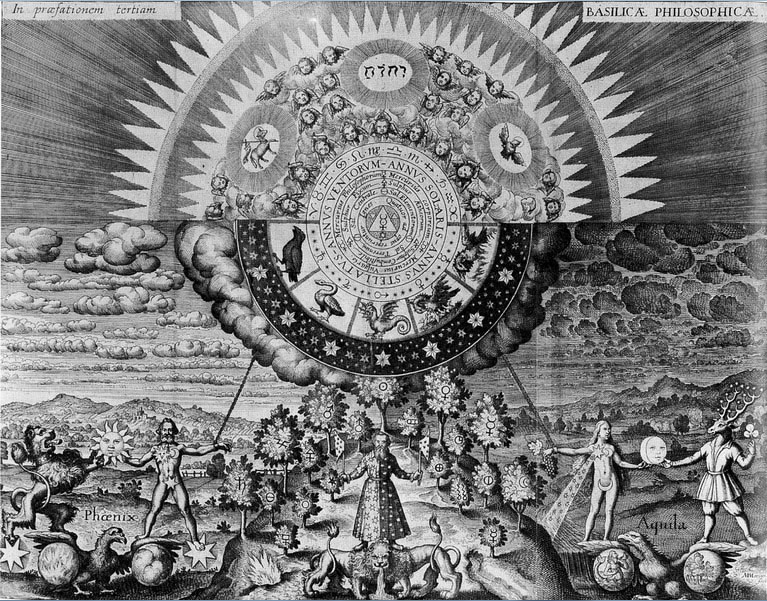The Rosicrucian Vault
1) The rose is a symbol of passion, the blood of Christ, and man's loss of paradise. A flower
with five petals also represents the fifth element and the pentagram. In Arabian Esotericism, a rose in the
centre of a cross symbolizes the union of opposites.
The name 'Rosenkreuzer' is first mentioned in the fourteenth century and refers to a number of
Adepts who rallied around the Rose Cross. The philosophy of Rosicrucianism became a synthesis of the
arts, religion, and science. The first Rosicrucian Manifesto, the Fama Fraternitatis, was published by a
secret fraternity in 1614.
2) The Vault described in the Fama Fraternitatis embodied their knowledge of Magia, Alchemy,
Christian Mysticism, and Cabala. Its secret door was discovered by one of the brothers to reveal the
sepulchre made as "a single compendium of the universe." The Rosicrucian Vault is a symbolic structure,
"that if it should happen after many hundred years, the Order or Fraternity should come to nothing, they
might by this onely Vault be restored again." (1)
The Vault is a seven-sided chamber with each wall measuring 5 X 8 units. Every side is divided into 10 squares
which are inscribed with figures and sentences. Drawers provide access to books and instruments. The ceiling
contains an artificial sun and is divided into 7 triangles. In the centre of the floor stands a round altar
covered with a brass plate. Buried underneath the altar is the body of Christian Rosenkreutz with parchment T.

3) The altar plate has an engraved design: the first ring reads 'Jesus mihi omnia'; in the middle
are four figures circumscribed with mottos which translate into 'The undefiled Glory of God', 'The Liberty of the
Gospel', 'The Yoke of the Law', and 'Nowhere, not at all, a Void.
The plate inspired a Rosy Cross in the 17th century book by Abraham von Franckenberg. Here the central circle
contains a jesuesque figure who holds the book of Seven Seals and letters of Alpha and Omega. His right hand is
surrounded by seven stars. On his breast are depicted a sapling, a black cross, and a flower with four petals.
4) The sixth Sephira on the Qabalistic Tree of Life is the Sphere of the Sun or Tiphareth. The
new Jerusalem is often associated with a golden cube that unfolds to a cross of six squares. The Hebrew word 'zahab'
means gold and the letters of this word (Zayin, He, Bet) add up to fourteen which is the perimeter in units of the
cross.
Eight is at Infinity above the Magician of the Tarot. The proportions of the walls [5 X 8] are in accordance
with the Golden Rectangle. 1 + 7 symbolizes the chalice and womb and refers to a period of change when higher
forces converge for spiritual growth. Ten correlates with Malkuth which is also the sphere of divination.
5) The Fama Fraternitatis concludes their description of the Vault as follows: "We have
covered it again with the plate, and set the altar thereon, shut the door, and made it sure, with all our seals."
Author: Marcel Ritschel, Date: Sydney 01.08.2001 (revised: 2017)
Acknowledgements
(1) 'Fama Fraternitatis', or, A Discovery of the Fraternity of the most laudable Order of the Rosy Cross, levity.com/alchemy
Rafal T. Prinke, 'The Great Work in the Theatre of the World', Article originally published in A Compendium
on the Rosicrucian Vault, ed. by Adam McLean, Edinburgh, 1985
Fra. Thomas D. Worrel, VII°, 'A Brief Study of the Rose Cross Symbol'; 'The Foundation and Content of
the Rosicrucian Manifestoes: A Brief Commentary'
Max Retschlag, 'Die Alchimie und ihr grosses Meisterwerk der Stein der Weisen', Richard Hummel Verlag,
Leipzig, 1934
'Die Zwölf Schlüssel des Basilius Valentinus' (Transcribed by Johann Plattner) Basilii Valentini
Benedictiner Ordens Chymische Texte Hamburg; In Verlegung Johann Naumans und Georg Wolff. Anno
M.DC.LXXVII.
